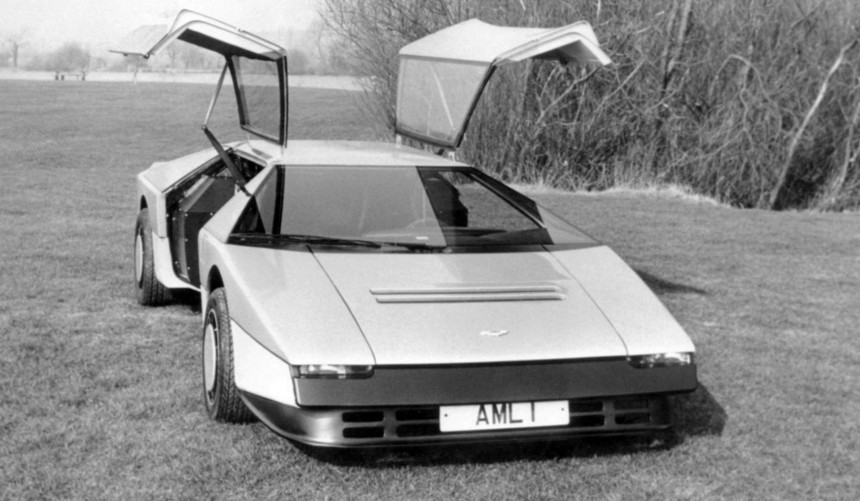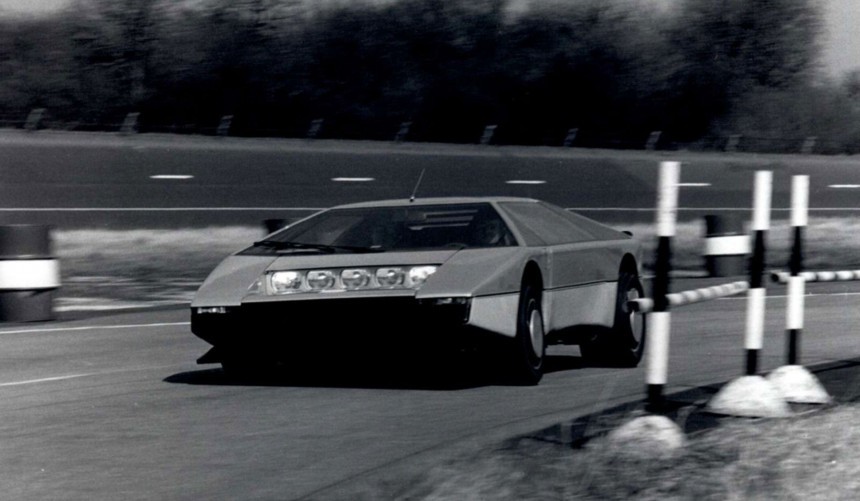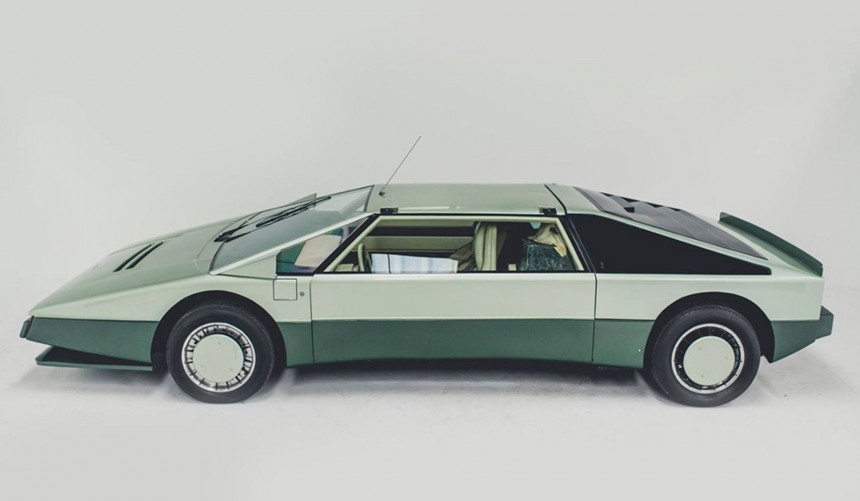Aston Martin once built a one-off that bizarrely called the Bulldog. It was very unlike anything the British brand had ever rolled out, both in terms of destination and design. But it was 1979, and they were testing the waters. They were hoping to make it the world's fastest production car. But it never happened. Instead, it had to wait for over 40 years to be able to hit 200 mph!
The Aston Martin Bulldog has recently been spotted in St. Moritz, Switzerland, braving the late-winter snow. Unfamiliar with the design, people stared at the model in wonder. What kind of contraption was that? It turns out that the Bulldog comes with an impressive story.
Codenamed DP K901, the Bulldog was originally supposed to be a limited run of 15-25 examples. But once they had it completed, the British decided production for each model would take too long and would be too expensive. So Aston Martin stopped at one.
The brand's executives decided to call it "Bulldog" as a tribute to an airplane flown by the automaker's managing director, Alan Curtis. It was a Scottish Aviation Bulldog aircraft nicknamed K9, after the robotic dog from the Doctor Who TV series.
Why did Aston Martin build a car that looked like complete nonsense? The automaker was trying to turn it into the fastest production car in the world. The model, a demonstration of futuristic technology, was a test bed in which the carmaker implanted all its best features.
It was designed by William Towns, the same who had designed the Lagonda sedan. It was powered by a mid-mounted 5.3-liter V8 engine with twin turbochargers, pumping out 600 horsepower (608 metric horsepower).
On a test bed, the ending could do even more: 700 horsepower (710 metric horsepower) and 500 pound-feet (678 Newton meters) of torque. That was a lot by 1979 standards.
Aston Martin officially unveiled the prototype on March 27, 1980, at the Bell Hotel in Aston Clinton, a historical village in Buckinghamshire, England. It had five headlights, two gullwing doors, and it was surprisingly a left-hand drive, even thought it was a 100-percent British product. The cabin featured leather upholstery and walnut trim, plus LED buttons.
The team that built it estimated it could hit 237 mph (381 kph). But it tragically failed. During testing at the Motor Industry Research Association track in late 1979, it didn't even get close to the figures its creators were dreaming of.
It was actually trailing far behind the estimates. Despite all the horsepower, the torque, and its wedge-shaped design which provided it with an impressive drag coefficient of only 0.34, the fastest that the Bulldog could run was 192 mph (309 kph).
The brand was planning to go along with it even though they could not market it as the world's fastest production model. But in 1981, Victor Gauntlett became the chairman of the company. It was he who canceled the project. It was too costly, it would take too long, and it was just the wrong car at the wrong time.
Three years later, Aston Martin sold it to a collector in the Middle East for 130,000 pounds. The engine reportedly blew up on his first drive. He fixed the car and took it to several events over the years, the 2009 Goodwood Festival of Speed included.
It was also present at the brand's centenary celebrations at Kensington Park Gardens in 2013. The car showed up with several modifications. It had rear-view mirrors and cameras installed.
At some point, it was painted green over the original silver and light gray. Its interior had also undergone modifications. The original dark brown and black leather was changed to light tan.
But except for these special events, it remained in storage, in a climate-controlled environment, never driven, never taken out into broad daylight.
In 2020, an American collector fell in love with it. So, the Bulldog set wheels in the US. Later on, it returned home to the United Kingdom. Philip Sarofim purchased it and wanted to restore it to its factory condition, so he asked Victor Gauntlett's son, Richard, to supervise the project.
He was also hoping to make it capable of reaching a top speed of 200 mph (322 kph). The restoration plans were ready by early 2021. The team worked day in and day out to get it ready.
By November 2021, the car was completed. During a run at the RNAS Yeovilton track, it did 162 mph (261 kph), which was far from what the American owner was hoping for. But he was not to give up.
On June 6, 2023, after a wait of 44 years, the car finally nailed it. During a run at the Campbeltown Airport, a former NATO base in Scotland, it finally reached its long-awaited 200 mph in the hands of works driver Darren Turn! It hit, in fact, 205.4 mph (330.5 kph).
Codenamed DP K901, the Bulldog was originally supposed to be a limited run of 15-25 examples. But once they had it completed, the British decided production for each model would take too long and would be too expensive. So Aston Martin stopped at one.
The brand's executives decided to call it "Bulldog" as a tribute to an airplane flown by the automaker's managing director, Alan Curtis. It was a Scottish Aviation Bulldog aircraft nicknamed K9, after the robotic dog from the Doctor Who TV series.
Why did Aston Martin build a car that looked like complete nonsense? The automaker was trying to turn it into the fastest production car in the world. The model, a demonstration of futuristic technology, was a test bed in which the carmaker implanted all its best features.
It was designed by William Towns, the same who had designed the Lagonda sedan. It was powered by a mid-mounted 5.3-liter V8 engine with twin turbochargers, pumping out 600 horsepower (608 metric horsepower).
Aston Martin officially unveiled the prototype on March 27, 1980, at the Bell Hotel in Aston Clinton, a historical village in Buckinghamshire, England. It had five headlights, two gullwing doors, and it was surprisingly a left-hand drive, even thought it was a 100-percent British product. The cabin featured leather upholstery and walnut trim, plus LED buttons.
The team that built it estimated it could hit 237 mph (381 kph). But it tragically failed. During testing at the Motor Industry Research Association track in late 1979, it didn't even get close to the figures its creators were dreaming of.
It was actually trailing far behind the estimates. Despite all the horsepower, the torque, and its wedge-shaped design which provided it with an impressive drag coefficient of only 0.34, the fastest that the Bulldog could run was 192 mph (309 kph).
Three years later, Aston Martin sold it to a collector in the Middle East for 130,000 pounds. The engine reportedly blew up on his first drive. He fixed the car and took it to several events over the years, the 2009 Goodwood Festival of Speed included.
It was also present at the brand's centenary celebrations at Kensington Park Gardens in 2013. The car showed up with several modifications. It had rear-view mirrors and cameras installed.
At some point, it was painted green over the original silver and light gray. Its interior had also undergone modifications. The original dark brown and black leather was changed to light tan.
In 2020, an American collector fell in love with it. So, the Bulldog set wheels in the US. Later on, it returned home to the United Kingdom. Philip Sarofim purchased it and wanted to restore it to its factory condition, so he asked Victor Gauntlett's son, Richard, to supervise the project.
He was also hoping to make it capable of reaching a top speed of 200 mph (322 kph). The restoration plans were ready by early 2021. The team worked day in and day out to get it ready.
By November 2021, the car was completed. During a run at the RNAS Yeovilton track, it did 162 mph (261 kph), which was far from what the American owner was hoping for. But he was not to give up.
On June 6, 2023, after a wait of 44 years, the car finally nailed it. During a run at the Campbeltown Airport, a former NATO base in Scotland, it finally reached its long-awaited 200 mph in the hands of works driver Darren Turn! It hit, in fact, 205.4 mph (330.5 kph).















